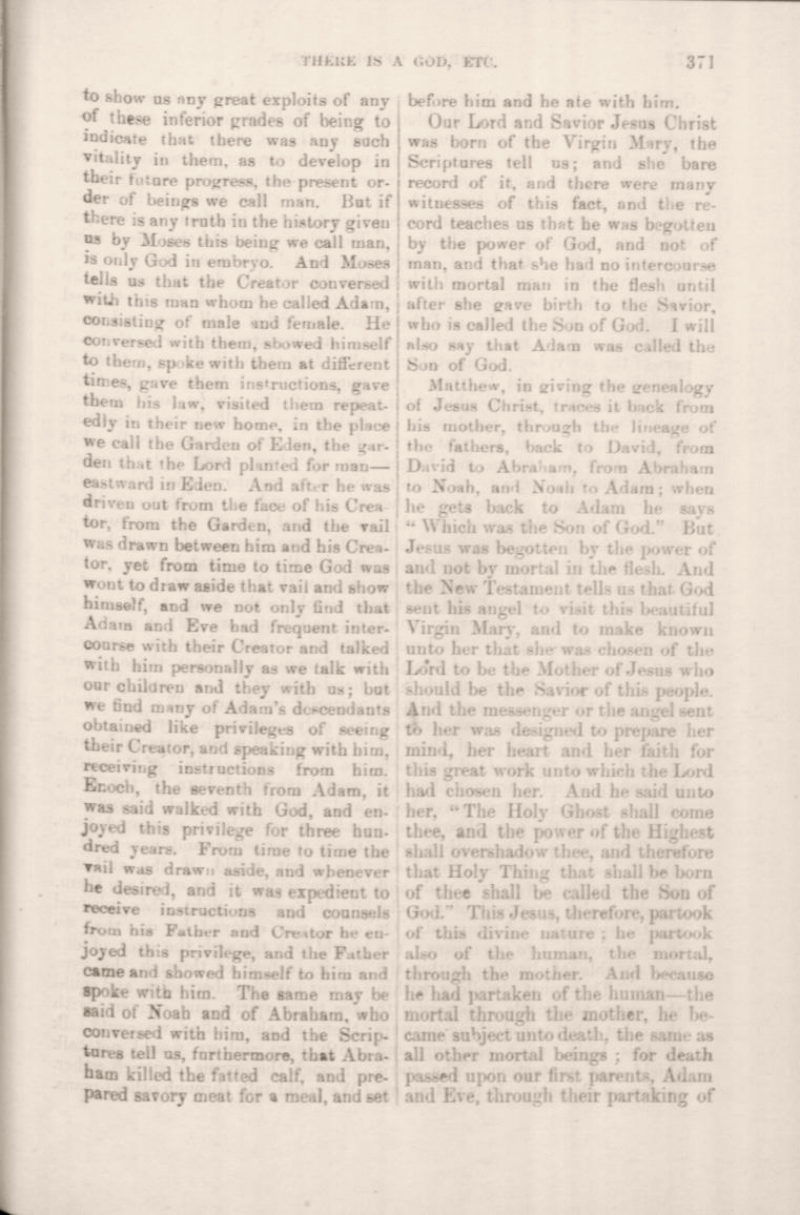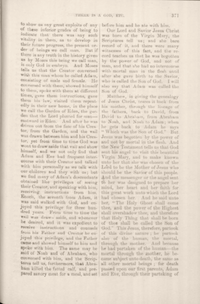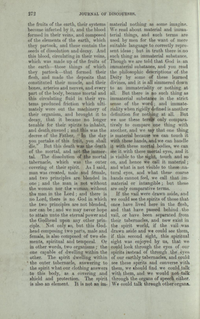Erastus Snow teaches that Adam is a "Son of God" and was placed in Eden by his God; the Godhead is composed of two parts: male and female.
- Type
- Speech / Court Transcript
- Hearsay
- Scribed Verbatim
- Reference
Erastus Snow, "There is a God—Communion With Him An Inherent Craving of the Human Heart—Man in His Image—Male and Female Created He Them—Spirit and Flesh—Mortal and Immortal," Journal of Discourses, 26 vols. (Liverpool: William Budge, 1878), 19:271-72.
- Scribe/Publisher
- Josiah Rogerson
- Audience
- Reading Public, Members of The Church of Jesus Christ of Latter-day Saints
- Transcription
And Moses tells us that the Creator conversed with this man whom he called Adam, consisting of male and female. He conversed with them, showed himself to them, spoke with them at different times, gave them instructions, gave them his law, visited them repeatedly in their new home, in the place we call the Garden of Eden, the garden that the Lord planted for man—eastward in Eden. And after he was driven out from the face of his Creator, from the Garden, and the vail was drawn between him and his Creator, yet from time to time God was wont to draw aside that vail and show himself, and we not only find that Adam and Eve had frequent intercourse with their Creator and talked with him personally as we talk with our children and they with us; but we find many of Adam's descendants obtained like privileges of seeing their Creator, and speaking with him, receiving instructions from him. Enoch, the seventh from Adam, it was said walked with God, and enjoyed this privilege for three hundred years. From time to time the vail was drawn aside, and whenever he desired, and it was expedient to receive instructions and counsels from his Father and Creator he enjoyed this privilege, and the Father came and showed himself to him and spoke with him. The same may be said of Noah and of Abraham, who conversed with him, and the Scriptures tell us, furthermore, that Abraham killed the fatted calf, and prepared savory meat for a meal, and set before him and he ate with him.
Our Lord and Savior Jesus Christ was born of the Virgin Mary, the Scriptures tell us; and she bare record of it, and there were many witnesses of this fact, and the record teaches us that he was begotten by the power of God, and not of man, and that she had no intercourse with mortal man in the flesh until after she gave birth to the Savior, who is called the Son of God. I will also say that Adam was called the Son of God.
Matthew, in giving the genealogy of Jesus Christ, traces it hack from his mother, through the lineage of the fathers, back to David, from David to Abraham, from Abraham to Noah, and Noah to Adam; when he gets back to Adam he says "Which was the Son of God." But Jesus was begotten by the power of and not by mortal in the flesh. And the New Testament tells us that God sent his angel to visit this beautiful Virgin Mary, and to make known unto her that she was chosen of the Lord to be the Mother of Jesus who should be the Savior of this people. And the messenger or the angel sent to her was designed to prepare her mind, her heart and her faith for this great work unto which the Lord had chosen her. And he said unto her, "The Holy Ghost shall come thee, and the power of the Highest shall overshadow thee, and therefore that Holy Thing that shall be born of thee shall be called the Son of God." This Jesus, therefore, partook of this divine nature; he partook also of the human, the mortal, through the mother. And because he had partaken of the human—the mortal through the another, he became subject unto death, the same as all other mortal beings; for death passed upon our first parents, Adam and Eve, through their partaking of the fruits of the earth, their systems become infected by it, and the blood formed in their veins, and composed of the elements of the earth, which they partook, and these contain the seeds of dissolution and decay. And this blood, circulating in their veins, which was made up of the fruits of the earth—those things of which they partook—that formed their flesh, and made the deposits that constituted their muscle, and their bones, arteries and nerves, and every part of the body, became mortal and this circulating fluid in their systems produced friction which ultimately wore out the machinery of their organism, and brought it to decay, that it became no longer tenable for their spirits to inhabit, and death ensued; and this was the decree of the Father, "In the day you partake of this fruit, you shall die." But this death was the death of the mortal, and not the immortal. The dissolution of the mortal tabernacle, which was the outer covering of their spirit. As I said, man was created, male and female, and two principles are blended in one; and the man is not without the woman nor the woman without the man in the Lord; and there is no Lord, there is no God in which the two principles are not blended, nor can be; and we may never hope to attain unto the eternal power and the Godhead upon any other principle. Not only go, but this Godhead composing two parts, male and female, is also composed of two elements, spiritual and temporal. Or in other words, two organisms; the one capable of dwelling within the other. The spirit dwelling within the outer tabernacle, answering to the spirit what our clothing answers to this body, as a covering and shield and protection. The spirit is also an element. It is not an immaterial nothing as some imagine. We read about material and immaterial things, and such terms are used by men for the want of more suitable language to correctly represent ideas; but in truth there is no such thing as immaterial substance. Though we are told that God is an immaterial substance, and you read the philosophic descriptions of the Deity by some of these learned divines, and it is all simmered down to an immateriality or nothing at all. But there is no such thing as immaterial substance in the strict sense of the word; and immateriality when rigidly defined is another definition for nothing at all. But we use these terms only comparatively to compare one thing with another, and we say that one thing is material because we can touch it with these hands, and we can handle it with these mortal bodies, we can see it with these mortal eyes, and it is visible to the sight, touch and so on, and hence we call it material; and what is not visible to these natural eyes, and what these coarse hands cannot feel, we call that immaterial or intangible; but these are only comparative terms.
- Citations in Mormonr Qnas
The B. H. Roberts Foundation is not owned by, operated by, or affiliated with the Church of Jesus Christ of Latter-day Saints.



